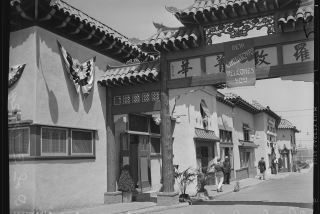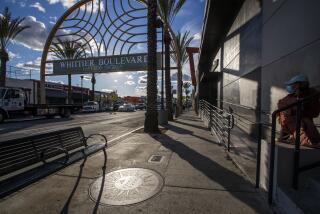‘Allensworth: 100 Years of the California Dream’ at the California African American Museum
- Share via
Out of the post-Reconstruction rubble, Col. Allen Allensworth, a retired African American army chaplain, pieced together a dream.
In 1908, Allensworth, a prominent Los Angeles resident, along with several other enterprising African American men (and their families), started a settlement 40 miles north of Bakersfield, in central California’s https://www. co.tulare.ca.us/about/allensworth.asp
Their 900-acre community was christened Allensworth, named after the man whose dream it was to build a black self-governed and self-sufficient colony. It would be a place, he hoped, where African Americans would “settle upon the bare desert and cause it to blossom as a rose.”
To mark the 100th anniversary of its founding, a new exhibit, “Allensworth: 100 Years of the California Dream,” recently opened at the California African American Museum. It chronicles the story of the all-black township -- its utopian beginnings, its hopeful middle period, its waning years and ultimately its designation as historic state park (in 1974) and piece-by-piece restoration. (The show is the result of a collaboration among CAAM, the California Department of Parks and Recreation and the California Community Empowerment Foundation.)
Allensworth was born into slavery in Kentucky in 1842. His idea, says historian, archivist and exhibition curator Susan D. Anderson, was “to found a town that would be a civic model so that Americans couldn’t have any justification for Jim Crow. Allensworth was a ‘sentiment maker’ -- today we would call it influencing public opinion -- so his idea was to ‘transform the public sentiment.’ ”
Allensworth was part of a little-known movement that was set in motion in reaction to the rise of Jim Crow, lynching and discriminatory statutes to uphold white supremacy that became prevalent in the South after the Civil War.
“It’s the period after Reconstruction, from 1877 to 1917, that in my opinion is the least studied period of American history,” Anderson said.
At its most dynamic, Allensworth township boasted 400 residents as well as its own voting and school districts, the first branch of the Tulare County library and the first black justice of the peace in the state.
Although Allensworth died in 1914, killed by a “reckless motorcyclist” in Monrovia, the spirit of Allensworth, the town, wouldn’t die. Even though the town began to struggle -- most dramatically, says Anderson, when the Sante Fe Railroad moved the depot and when low water levels in the region made it difficult for farmers to irrigate their crops -- the town chugged on.
“I know a lot of people who went to school there in the ‘30s, ‘40s and ‘50s and others who attended the Baptist church, which also served as a meeting place,” said Anderson, who said she found it sad that so few people knew about Allensworth and its larger story -- “the role African Americans have played in this country’s growth.”
Along the way, a headline in a magazine profile about Allensworth stuck: “The Town That Refused to Die.” But Anderson believes the town and its memory have come to stand for something much more profound and nuanced: “The elegance, grace and power of this culture.”
More to Read
The biggest entertainment stories
Get our big stories about Hollywood, film, television, music, arts, culture and more right in your inbox as soon as they publish.
You may occasionally receive promotional content from the Los Angeles Times.










